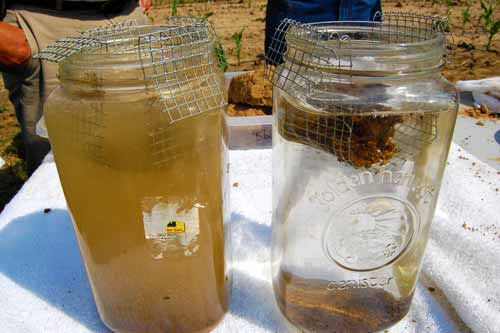Target tillage to protect the soil
Timing and intensity of spring tillage can have long-term impacts on soil health.
Every year about this time (late April), a deep agrarian urge to turn the soil takes hold of many. Tillage has epitomized a farmer’s relationship with the land for nearly 10 millennia and, until recently, spring tillage was considered an essential tool for weeding, amendment incorporation and seedbed preparation prior to planting. However, soil scientists and growers are becoming increasingly aware of the long-term negative impacts mechanical disturbance can have on soil health.
Tilling destroys soil’s natural structure, breaking-up colloids and collapsing macro pores. The short-term result is a warmer, aerated and competition-free environment suited to seed germination. Yet, the fine particles and small pores characteristic of tilled soil are ultimately unstable, leaving fields vulnerable to erosion and compaction over time.
Tillage can also alter soil ecosystems. Research has shown that decomposition rates often increase behind the plow, hastening the breakdown of soil organic matter and subsequent release of carbon dioxide into the atmosphere. Organic matter loss paired with the drying effect of tillage dramatically limits soil water holding capacity and moisture available for plant growth.

The structure of soil under conventional tillage (left) degrades quickly when exposed to water. Soil under conservation tillage (right) forms stable aggregates that resist erosion. Photo credit: Chesapeake Bay Program
All of these concerns have spurred the development of reduced tillage cropping systems in recent decades. Herbicides, tolerant crop varieties and innovative equipment now make it possible to control weeds and plant a field without upsetting the ground. Michigan State University Extension research on tillage effects on soybean yields in Michigan has demonstrated that no-till cropping systems can also yield as well as conventional systems. This spring, no-till may be an especially attractive option for Michigan growers thanks to a winter of multiple freeze-thaw cycles that loosened soils across the Midwest.
Yet, there are cropping systems and situations where few alternatives to tillage are available. For example, when tillage is minimized, crop stover often builds-up on the soil surface. A certain amount of surface residue protects against erosion and excessive soil drying, but too much can keep soils wet and cool, complicating early-season field work. Shallow tillage is often the only practical way to manage this excess of surface residue.
The production of certain crops, like potatoes, requires significant soil disturbance. Innovative systems have been developed to reduce tillage in potato production, but conventional seedbed preparation, hilling and harvest operations used by the majority of growers move a lot of soil.
Tillage is also necessary in organic cropping systems. Without viable chemical control options, organic growers rely on tillage to kill and incorporate weeds or cover crops. In these and other circumstances where spring tillage cannot be avoided, it is important to consider how the timing and intensity of operations can be managed to minimize any negative impact. The points below offer some practical guidance to sorting this out.
Timing
- Before tilling, check soil moisture to a few inches below the anticipated tillage depth to make sure the field is sufficiently dry.
- It is hard to be patient, but tilling too early increases the likelihood of soil compaction, non-uniform soil moisture, crusting and clodding.
- When tilling for seedbed preparation, a single pass just prior to planting will maximize moisture uniformity and minimize water loss from the seed zone compared to multiple passes.
- Each additional spring tillage pass increases the potential for soil erosion, compaction and excessive drying while also adding to production costs.
Intensity
- If primary tillage was completed in the fall, consider no-till options for weed control and planting this spring.
- When tillage is necessary, choose the least aggressive implement and run it as shallow as possible to meet your objectives.
References
- Agronomist: Winter weather loosened soil; no-till a viable option, Purdue Agriculture News
- Spring Tillage Preparation, Iowa State University Extension Integrated Crop Management News
- Just say no to spring tillage, NRCS advises, Carbon County Utah Sun Advocate.
- Timing of Tillage Crucial to Crops, Soil Science Society of America



 Print
Print Email
Email
